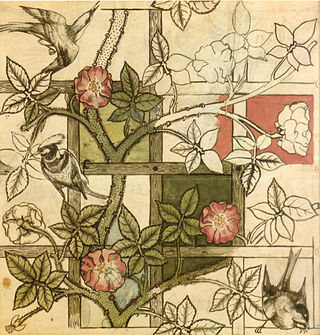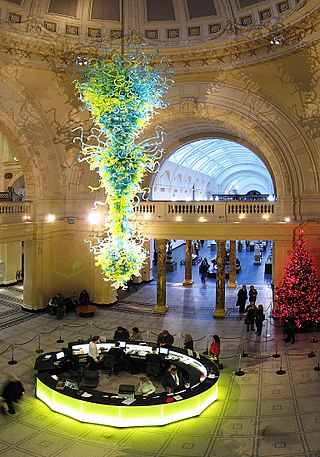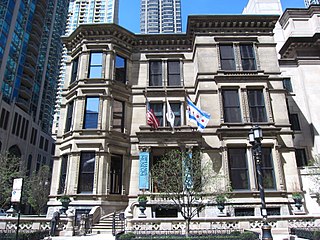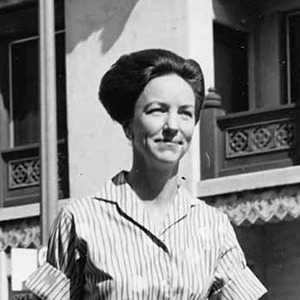
The Arts and Crafts movement was an international trend in the decorative and fine arts that developed earliest and most fully in the British Isles and subsequently spread across the British Empire and to the rest of Europe and America.

A bungalow is a small house or cottage that is single-story, and may be surrounded by wide verandas.

The Fan is a district of Richmond, Virginia, so named because of the "fan" shape of the array of streets that extend west from Belvidere Street, on the eastern edge of Monroe Park, westward to Arthur Ashe Boulevard. However, the streets rapidly resemble a grid after they go through what is now Virginia Commonwealth University. The Fan is one of the easterly points of the city's West End section, and is bordered to the north by Broad Street and to the south by VA 195, although the Fan District Association considers the southern border to be the properties abutting the south side of Main Street. The western side is sometimes called the Upper Fan and the eastern side the Lower Fan, though confusingly the Uptown district is located near VCU in the Lower Fan. Many cafes and locally owned restaurants are located here, as well as historic Monument Avenue, a boulevard formerly featuring statuary of the Civil War's Confederate president and generals. The only current statue is a more modern one of tennis icon Arthur Ashe. Development of the Fan district was strongly influenced by the City Beautiful movement of the late 19th century.

Gustav Stickley was an American furniture manufacturer, design leader, publisher, and a leading voice in the American Arts and Crafts movement. Stickley's design philosophy was a major influence on American Craftsman architecture.

Prairie School is a late 19th and early 20th-century architectural style, most common in the Midwestern United States. The style is usually marked by horizontal lines, flat or hipped roofs with broad overhanging eaves, windows grouped in horizontal bands, integration with the landscape, solid construction, craftsmanship, and discipline in the use of ornament. Horizontal lines were thought to evoke and relate to the wide, flat, treeless expanses of America's native prairie landscape.

California bungalow is an alternative name for the American Craftsman style of residential architecture, when it was applied to small-to-medium-sized homes rather than the large "ultimate bungalow" houses of designers like Greene and Greene. California bungalows became popular in suburban neighborhoods across the United States, and to varying extents elsewhere, from around 1910 to 1939.

Greene and Greene was an architectural firm established by brothers Charles Sumner Greene (1868–1957) and Henry Mather Greene, influential early 20th Century American architects. Active primarily in California, their houses and larger-scale ultimate bungalows are prime exemplars of the American Arts and Crafts Movement.
Winnetka Heights is one of the oldest and largest historical districts in the Oak Cliff section of Dallas, Texas (USA). The district is bounded by Davis Street on the north, 12th Street on the south, Willomet Avenue on the east and Rosemont Avenue on the west. Established in 1910, Winnetka Heights consists of early 20th century wood-frame houses.

American craft is craft work produced by independent studio artists working with traditional craft materials and processes. Examples include wood, glass, clay (ceramics), textiles, and metal (metalworking). Studio craft works tend to either serve or allude to a functional or utilitarian purpose, although they are just as often handled and exhibited in ways similar to visual art objects.

South Park is a neighborhood in San Diego, California adjacent to the southeast corner of Balboa Park. It stands out in San Diego for its tree-lined streets and walkable business district.

American Craftsman is an American domestic architectural style, inspired by the Arts and Crafts movement, which included interior design, landscape design, applied arts, and decorative arts, beginning in the last years of the 19th century. Its immediate ancestors in American architecture are the Shingle style, which began the move away from Victorian ornamentation toward simpler forms, and the Prairie style of Frank Lloyd Wright.

George Washington Maher was an American architect during the first quarter of the 20th century. He is considered part of the Prairie School-style and was known for blending traditional architecture with the Arts & Crafts-style.

The Thomas Gould Jr. House is a historic house located at 402 Lynn Drive in Ventura, California. Architect Henry Mather Greene designed the American Craftsman style California bungalow, which was built in 1924. The house is considered one of the best examples of Henry Greene's independent work; most of his other designs were created alongside his brother Charles as Greene & Greene. The two-story house has a wood frame and redwood siding and window casings. The gable roof features truncated ends and a small gable on the front side which resembles a dormer. The house's interior decorations include ceiling moldings, a leaded glass china cabinet, and a carved mirror, the latter being the only piece of furniture designed by Greene himself.

Mission furniture is a style of furniture that originated in the late 19th century. It traces its origins to a chair made by A.J. Forbes around 1894 for San Francisco's Swedenborgian Church. The term mission furniture was first popularized by Joseph P. McHugh of New York, a furniture manufacturer and retailer who copied these chairs and offered a line of stylistically related furnishings by 1898. The word mission references the Spanish missions throughout colonial California, though the design of most Mission Style furniture owed little to the original furnishings of these missions. The style became increasingly popular following the 1901 Pan-American Exposition in Buffalo. The style was popularly associated with the American Arts and Crafts movement.
In the United States, the National Register of Historic Places classifies its listings by various types of architecture. Listed properties often are given one or more of 40 standard architectural style classifications that appear in the National Register Information System (NRIS) database. Other properties are given a custom architectural description with "vernacular" or other qualifiers, and others have no style classification. Many National Register-listed properties do not fit into the several categories listed here, or they fit into more specialized subcategories.
Alexander Stewart Jolly (1887–1957) was a Sydney-based architect, published poet and children's author in the early 20th century. His buildings are primarily in Sydney's northern suburbs and the north coast of New South Wales. His architectural work was strongly influenced by Frank Lloyd Wright’s School in Chicago, as well as the Arts and Crafts movement of the time.

The Richard H. Driehaus Museum is a museum located at 40 East Erie Street on the Near North Side in Chicago, Illinois, near the Magnificent Mile. The museum is housed within the historic Samuel M. Nickerson House, the 1883 residence of a wealthy Chicago banker. Although the mansion has been restored, the Driehaus Museum does not re-create the Nickerson period but rather broadly interprets and displays the prevailing design, architecture, and decorating tastes of Gilded Age America and the art nouveau era in permanent and special exhibitions.
The Maysville Historic District is a historic district in Mobile, Alabama, United States. The district covers 451 acres (183 ha) and contains 1121 properties located southwest of downtown and directly south of the Leinkauf Historic District. Platted in 1871 in the midst of a recession in Mobile, the neighborhood did not begin to develop until the late 1890s. Maysville has long been a working class neighborhood; many late 1890s and early 1900s houses were bungalows and cottages, some with modest Victorian influences. Some larger and more decorated houses were built in the northeastern portion of the neighborhood. In the early 20th century and into World War I and World War II, the Port of Mobile and its shipyards became a focus of Mobile's economy, and the population grew in response. The early 20th century saw many craftsman-style bungalows and four square houses built. Minimalist Traditional and some ranch-style houses became popular around and after World War II. Notable contributing buildings in the district are Ladd–Peebles Stadium, built in 1948, and Williamson High School, built in 1965. The district was listed on the National Register of Historic Places in 2013.

Eudorah Moore was an American curator and patron of the arts. She is regarded as revolutionizing California design, and for her advocacy of craft as an art form.














